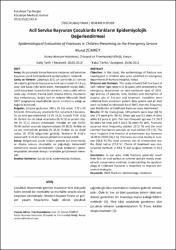Acil servise başvuran çocuklarda kırıkların epidemiyolojik değerlendirmesi
Abstract
Amaç: Bu çalışmada Konya Numune Hastanesi acil servisine
başvuran çocuk hastalarda kırık epidemiyolojisi incelendi.
Gereç ve Yöntem: Çalışmaya 2011 yılı içerisinde acil servise
tek rakamlı günlerde başvuran ve kırık tanısı konan 0-14 yaş
arası 528 hasta (540 kırık) alındı. Retrospektif olarak elektronik
hasta kayıt sistemlerinin taranması sonucu elde edilen
hasta yaşı, cinsiyet, travma saati, travma ortamı, travmanın
oluş mekanizması, kırığın yeri ve tedavisi Microsoft Excel
2007 programına kaydedilerek çocuk kırıklarının sıklığı ve
dağılımı belirlendi.
Bulgular: Çalışma grubunun 349’u (% 66) erkek, 179’u (%
34) kızdı. Ortalama yaş erkeklerde 9,5, kızlarda 8,2 bulundu.
En sık kırık yaşı erkeklerde 13 (% 14,3), kızlarda 9 (% 10,6)
idi. Kırıklar en sık sokak ortamında (% 37,5) ve yerden düş-
me (% 57,1) sonucu olmaktaydı. Hastalar en çok 16:00-
20:00 saatleri arasında başvurmaktaydı (% 36,2). Kırıklar en
sık yaz mevsiminde görüldü (% 38,5). Kırıklar en sık distal
radius (% 27,9) bölgesinde görüldü. Kırıkların % 84,6’sı
konservatif, % 15,4’ü cerrahi yöntemlerle tedavi edildi.
Sonuç: Bölgemizde çocuk kırıkları genelde yaz mevsiminde
ve düşme sonucu oluşmakta ve çoğunluğu konservatif
yöntemlerle tedavi edilmektedir. Çocuk kırıklarının epidemiyolojisini
anlamak önleyici stratejiler geliştirmede önemlidir. Objective: In this study, the epidemiology of fracture was
investigated in children who were admitted to emergency
department of Numune Hospital, Konya.
Material and Methods: This study included 540 fractures of
528 children (age range 0 to 14 years) who presented to the
emergency department on odd-numbered days of 2011.
Age and sex of patients, time, location and mechanism of
trauma, site of fracture and treatment modalities were
collected from electronic patient data system and all data
were recorded on Microsoft Excel 2007, then the frequency
and distribution of childhood fractures were determined.
Results: Of the study group, 349 patients were boys (66 %)
and 179 were girls (34 %). Mean age was 9,5 years in boys
while 8,2 years in girls. The most frequent age was 13 (14,3
%) years for boys and 9 (10,6 %) years for girls. Fractures
occurred most frequently outdoor (37,5 %) and the most
common mechanism was falls on level surface (57,1 %). The
most frequent time interval of presentation was between
16:00 to 20:00 (36,2 %). Fractures occurred mostly in summer
(38,5 %).The most common site of involvement was
the distal radius (27,9 %). Choice of treatment was conservative
methods in 84,6 % and surgical methods in 15,4
%.
Conclusion: In our area, child fractures generally result
from falls on level surface in summer and are mostly treated
with conservative methods. Understanding the epidemiology
of childhood fractures is important to improve preventive
strategies.
Source
Afyon Kocatepe Üniversitesi, Kocatepe Tıp DergisiVolume
15Issue
2Collections
- Kocatepe Tıp Dergisi [154]



















